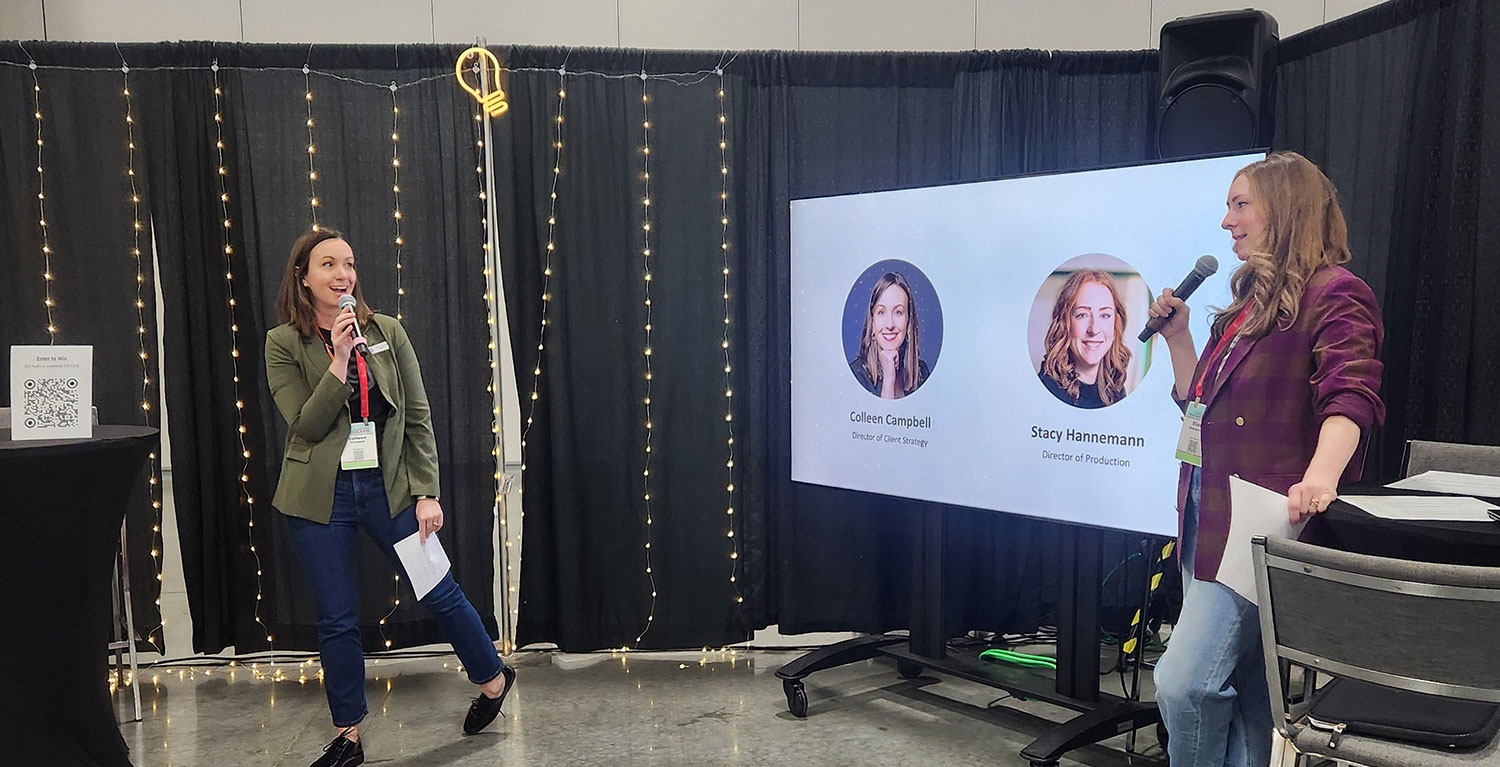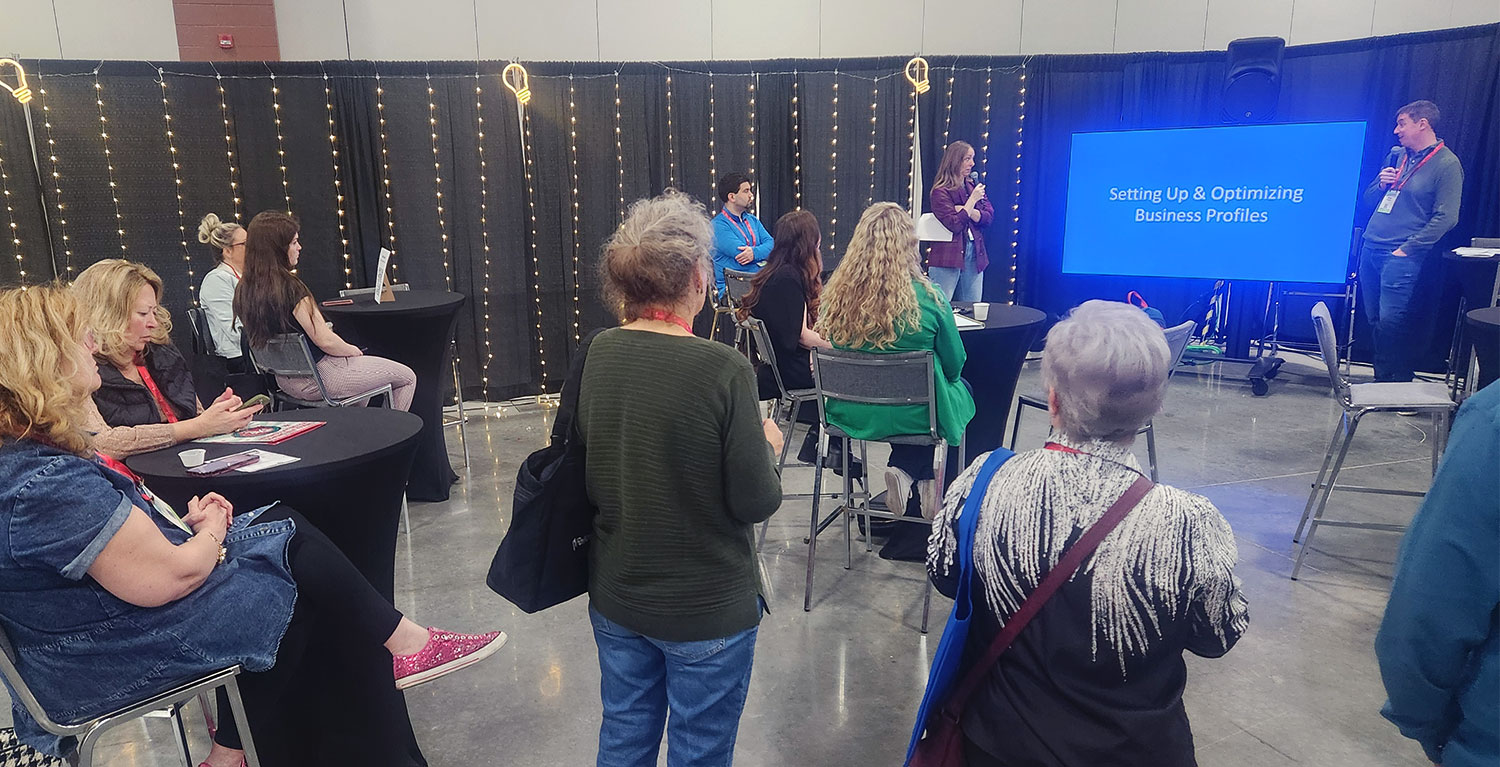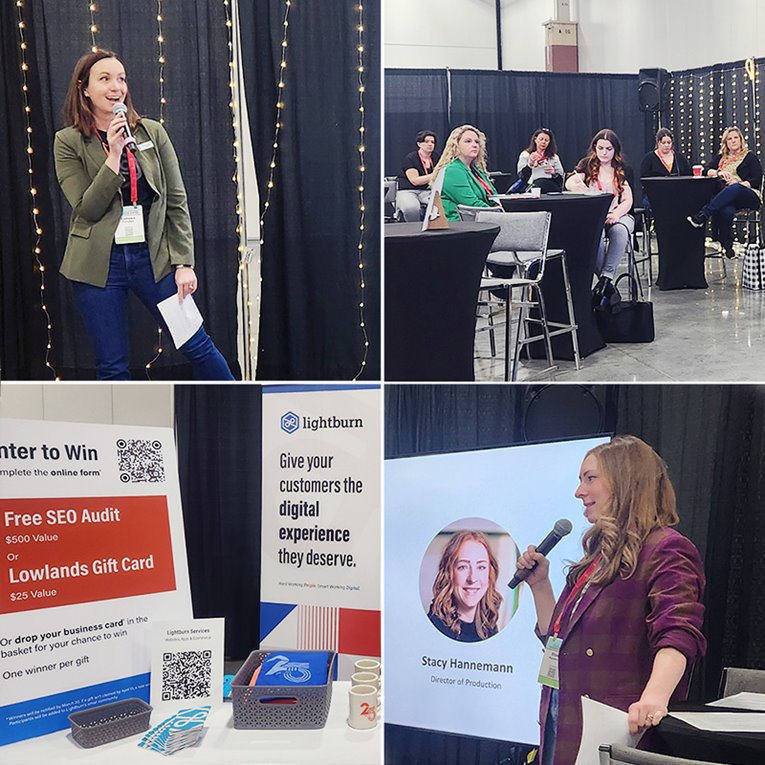Wisconsin artisans and entrepreneurs of the food, beverage and hospitality industry gathered for the 2024 Wisconsin Food & Hospitality Expo on March 13. The event shined a spotlight on businesses of all sizes with unique products and services.
During the event, Lightburn was proud to have played multiple roles — sponsor, exhibitor and host of the six-part “Quick Bite” speaker series specific to web and digital marketing.
Throughout the day, leaders shared real-world examples of how our Food & Beverage and ecommerce partners successfully showcase, sell and promote their products online.
Below are the top takeaways from all six discussions:
1. A Good Website Doesn’t Need to be Complex
Hosted by Lightburn’s Director of Client Strategy, Colleen Campbell and Director of Production Stacy Hannemann. This discussion focused on why having a small website is better than nothing. From menus to maps, we shared what you need for a successful F&B website.
Top takeaways:
Get found by local customers
Even though social media pages like Facebook have become an attractive place for businesses to host profiles, people don’t search Facebook like they do on Google or Bing. Being found via search engines is largely centered around websites. Simple websites appear more professional and drive traffic even if you only have 3-5 pages.
Don’t duplicate your efforts
Wix, Square Space, Web flow, or an extension of your POS platform offer plenty of template options — but your sales, product or search engine optimization options are often limited. Though we are platform agnostic, WordPress’s Guttenberg offers more flexibility and scalability than other platforms. It also has a multisite option if you have an umbrella of brands. Above all, it’s largely supported. WordPress and plug-in developers consistently help business owners.
A rule of thumb for choosing WordPress plug-ins
It’s wise to go with those that have been downloaded at least 1000 times and have positive reviews. Look for plug-ins that are owned by developers with other applications, so you have a direct point of contact for troubleshooting. If you’re interested in paid plug-ins, opt for those with free trials. Don’t hesitate to ask to adjust what tier you’re on or ask for a refund if the solution doesn’t work for you. You’d be surprised how many times they’ll help!
Focus on the four things that actually help your customers
- Have quality photos to show exactly how your business, products, storefront, or processes work — it’s authentic.
- Host HTML versions of your menus or products. Read that again. It’s easier to maintain, stay up-to-date, and share online and in store.
- Make FAQs and logistics, such as clickable directions, phone numbers, and emails clearly available.
- Elevate pertinent information so it’s very easy to find, including parking, accessibility and dietary-restriction options.
Three behind-the-scenes must-haves
A website can be a well-oiled machine if you have the parts in place. And there are a lot of things that your customers don’t see that can make your life and theirs easier. Have an image optimization plug-in or tool. You do want beautiful imagery, but you do not want it to negatively impact site performance. Slow websites are painful. If you’re using WordPress, use the Yoast SEO plugin. It will make the website easier to find and easier to share. Use Gravity Forms for all your needs. It’s easy to set up and create notifications, and can easily integrate into other tools.

2. Get Found: Better Reach Local Customers
Hosted by Lightburn’s Director of Production Stacy Hanneman and Director of Marketing Clay Patterson. From claiming business profiles to Local SEO packs and review management, our team shared the checklist of must-haves every local business needs to get found online.
Top takeaways:
The world's shortest explanation of SEO as a practice
Search engine optimization is the practice of configuring your website to be indexed and ranked highly for applicable search terms by Google and other search engines. There are two main ways to look at SEO: from the technical side and the content side. Both are important and both need to be updated regularly.
The evolution of SEO
You’ll notice there is a wide variation of online search results from one day to the next. The days of getting 10 organic results and 10 ads are over. Now you see event listings, shopping ads, images, knowledge, panels, Q&A’s — and then local results. Google, for example, used to want to send you off to other websites to get answers. But now they want you to stay on Google properties as long as possible.
Reaching people near your business
Have you ever searched for a product “Near You”? People are looking for rich and accurate results specific to them. And it’s up to you to be visible in that space. To do that, you need to claim your business profiles and update them regularly. In fact, there are a lot of free marketing tools you can use within the profile itself. Accurately categorize your business, include a robust number of details, appealing photos, correct hours of business, current phone numbers and reviews. Link all of these to your website and separate locations if applicable so you show up in multiple areas.
3. Using Marketing Tactics to Recruit
Hosted by Lightburn’s director of marketing, Clay Patterson and the Marketing Director for Jones Dairy Farms, Lisa Caras. For attendees in a pick with recruitment, Jones shared how they worked with Lightburn to boost hiring efforts.
Top takeaways:
Recruiting and hiring may need to be a marketing initiative
Jones’s staffing challenges had become so significant, it was hampering nearly every aspect of the company — they weren’t able to keep up with production demand, were having to turn down large opportunities for growth, and had bottlenecks throughout the organization. This is when they realized they needed marketing support to craft strong messages and a convincing sales pitch for jobseekers that Jones Dairy Farm is a great place to work.
Every jobseeker is different; it’s not one-size-fits-all
It’s hard to narrow down the 1-2 things that are going to resonate and be most important to a potential applicant. Some may prioritize shifts/hours that work best for their family, others may want proximity to home, or perhaps company culture is a key consideration. Jones did an excellent job crafting a variety of compelling messaging and video content that touches on the many unique benefits of working for them and all they have to offer. Especially compelling was video content from current employees extolling the virtues of working for Jones.
Using search engines rather than job boards
People often start their job search on Google, not a traditional job board. And no matter how they find the Careers section of your site, retargeting them around the web and on YouTube/Facebook/Instagram is an effective way to stay in front of potential candidates and continue building your case to come work for you. Companies typically think about paid advertising platforms as a vehicle to sell and market their products or services, but they can be just as effective at selling the company itself as a great destination to work.
4. Selling Merchandise & Brand Goods
Hosted by Lightburn’s Director of Client Strategy, Colleen Campbell and our Director of Production, Stacy Hanneman. From web to cart to doorstep, attendees heard how Milwaukee’s very own Lowlands Group used Shopify to build a free-standing retail store for their merchandise.
Top takeaways:
Identify which challenges are holding you back
Often businesses don’t have a homepage for their store. Without the right platform, you may not be able to set up product tags or categories. Setup is sometimes so basic that you can’t collect data from accounts, track, conversions or run reports. This makes it even more difficult to optimize, ship profiles, offer discounts, or create promotions.
Shopify really is easy for retail
Shopify allows you to choose from awesome templates, access reports, create accounts for re-ordering, have unique local and semi-local shipping profiles, and share individualized categories. For Lowlands Group, individual branding and categorization was vital. They needed to filter products by type and by collection, simplify the product ordering and allow their team to self-manage promotions and sell gift cards.
Selling online doesn’t have to be difficult
Simple and fast are different things. Have your ducks in a row before you get started. Do you have a solid catalog, clear descriptions, photos of your products, and a proven fulfillment process? If so, you’ll be able to rebuild that online and make it easy to manage new products, promotions, and customer service without being overwhelmed. Consider how you’re going to manage your categories and cross-sell products.

5. The Effects of Seasonality on Retail Brands
Hosted by Lightburn’s Director of Production Stacy Hanneman and Director of Marketing Clay Patterson. This discussion focused on the top of ways seasonality impacts ecommerce and paid marketing strategies, featuring Wisconsin’s very own Racine Danish Kringles.
Top takeaways:
Prepare your team and website for peak season
Sync with your team and allow plenty of time to adjust your website and ensure all content is accurate and up to date for the newest season. Test all lead forms and make sure your hosting provider can handle the increase in volume.
How to manage and capitalize during peak season
Businesses often refrain from advertising during peak season because they feel they don’t really need to. But if you do run ads, you can use that data in your favor. Test different messages, channels and ad types. You’ll get data so quickly that you’ll be able to pivot toward the most successful campaigns. Change can be intimidating during your busiest times, but it can often be the most rewarding.
How to reach customers during off-season
After the dust settles and you’re into a less busy time of year, you can start making creative decisions for next season. Grab your most successful campaigns and see how effective they are now. You can take this time to refresh materials or consider new ways to increase purchases. Consider ways to springboard off other seasons and holidays or create your own. Amazon created Prime Day specifically to drive traffic during their least busy months while pushing lesser known products.
6. Email & SMS Marketing for F&B
Hosted by Lightburn’s Director of Marketing Clay Patterson and Director of Client Strategy Colleen Campbell. During the session, we discussed how to use email and SMS marketing to connect with your customers. Building a program is easier to manage and much more impactful than you may think.
Top takeaways:
Take the time you need to set up correctly
Really consider what you’re going to say. What’s your concert plan and what are your fallback options? Emails may only take a few minutes to read but it likely took someone a few hours to create. Even though the written word can be spontaneous, good imagery, video and applicable supporting links can take time.
Don’t get in your own way
Programs frequently have false-starts. We often hear: “I don’t have any news to share,” “I don’t have a big email list,” or “Who’s going to care?” These worries get in the way of starting when really, there is an audience for everything — even if your service isn’t sexy. If it helps people understand something better, there will be interest. The good thing about a small email list is that you’ll be able to test-drive several platforms for free while you learn and grow.
When and how to use SMS marketing
Text marketing has a very specific purpose. Communications need to be shorter and are time sensitive. This is the channel to discuss flash sales, not to share that your business will be at a farmers market next spring. However, if you’re going to a farmers market the next day, share that with your audience. There are several tools that host email and text marketing automations. We really like Klaviyo, but other tools are available.
Build Mouth-Watering Digital Experiences
Food & Beverage, and ecommerce revenue is projected to exceed $16 billion this year. With the right strategy, technology and logistics in place, you can take home a piece of that pie.
Whether you need a website, app or online sales support, Lightburn can help ensure your in-house team has everything they need to share your delicious treats with the world.
